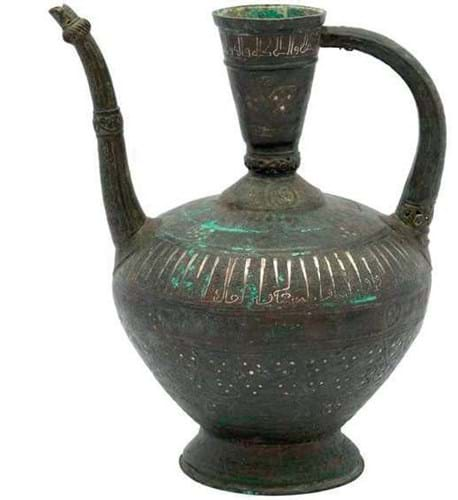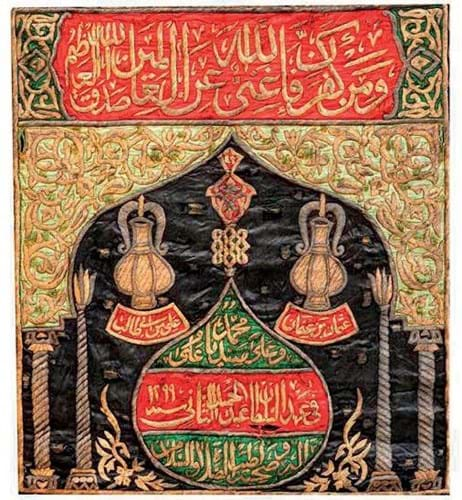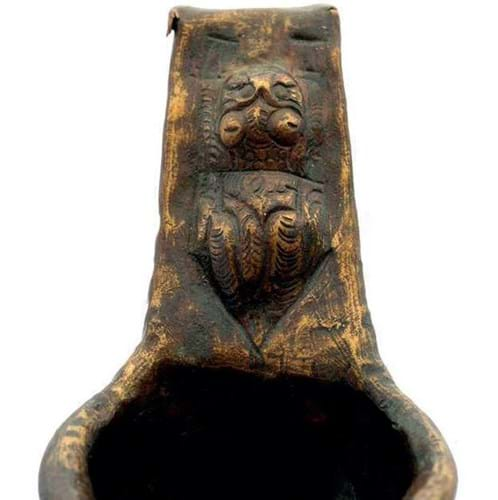In the years before the Mughal conquest the trading centre of Herat was a renowned metalworking centre.
It was particularly celebrated for its range of silver and copper-inlaid vessels that were typically decorated with repoussé animal and figural motifs.
Two of these ‘golden age’ copper alloy ewers made in eastern Iran, c.1180-1220, sold well above expectations at Chiswick Auctions (25% buyer’s premium).
Guided at £2000-3000 on October 31 but sold at £7500 was a cylindrical ewer with a beak-like spout and a decorative scheme combining lions with lunar roundels.
This combination of the terrestrial and the celestial is known from several other surviving examples, including a ewer in the Louvre collection.
Ewers of this period are associated with courtly gatherings and the serving of wine, water and other beverages during festivities. However, they were also used for the washing of hands prior to prayer when decoration of a more overtly spiritual nature was appropriate.

Herat copper alloy ewer engraved with overlapping bands of prayers and blessings, £9000 at Chiswick Auctions.
From the same period, also offered in west London was a silver-inlaid bronze pyriform ewer finely engraved with overlapping bands of prayers and blessings in Kufic and Naskhi scripts. It went well above its £1500-2000 estimate to sell at £9000.

Herat copper alloy ewer engraved with overlapping bands of prayers and blessings, £9000 at Chiswick Auctions.
Both ewers were part of the sixth and final part of a private European collection of Persian works of art that the saleroom has offered over three years. This dispersal was overseen by Chiswick Auctions’ specialist Beatrice Campi who has recently left the firm.
The 84 lots offered here were again a near sell-out, bringing a total of £143,000 (including buyer’s premium).
Fortunate camel

Ceremonial mahmal made at the Dar al-Kiswa textile workshop in Cairo for a Hajj pilgrimage, £9000 at Chiswick Auctions.
Leading the line at Chiswick Auctions’ mixed-vendor sale in the afternoon was a ceremonial mahmal (palanquin) made at the famed Dar al-Kiswa textile workshop in Cairo for the Hajj pilgrimage of 1299AH (1881-82).
Worked with Quranic texts and representations of mosque lamps in metal threads to a ground of black, pale blue, red, and green silk, it would have been carried by camel at the head of the 50-plus day hajj procession to and from Mecca.
Such textiles were much revered and even the beast of burden that carried them gained special status. After arriving back in Cairo, a mahmal camel was exempted from carrying any load for the remainder of its life.

Ceremonial mahmal made at the Dar al-Kiswa textile workshop in Cairo for a Hajj pilgrimage, £9000 at Chiswick Auctions.
This splendid example is embroidered with the date 1299AH and the name of the Ottoman Sultan Abdul Hamid II (r.1876-1909) who will have paid for its commissioning.
At the time the Dar al-Kiswa workshop employed over 100 craftsmen to make these and other sacred textiles annually for Islamic holy sites.
Estimated at £4000-6000, it sold at £9000.
















